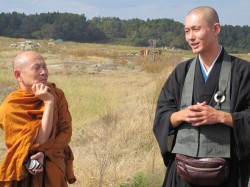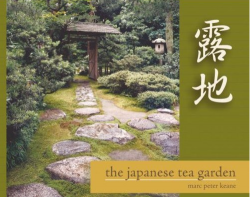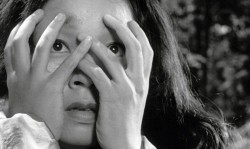Reviews
“The Fortunate Earth is Happy”
As I sat down to read On Freedom: Spirit, Art, and State, one of the first thoughts I had was how difficult it is to peg a term as loaded as “Freedom.” At about the same moment as I had this thought, the chorus of the jaunty Calypso song on my stereo sang out, “Always remember somebody suffering more than you.
Read MoreAshoka’s Dream
Years after an unexpected encounter with the remarkable reign of Emperor Ashoka Maurya, Bruce Rich has written an insightful meditation on the relevance of the ancient Indian ruler to our own age of global discontent.
Read MoreNuclear Japan and the Four Noble Truths
Despite considerable inertia in a religion well known for its conservatism, the protagonists in this book are seizing this opportunity to apply Buddhist values in opposition to nuclear power, and also to respond to the crisis in ways that invest Buddhist values with new relevance to contemporary society.
Read MoreThe Rhetoric of Life: S. Brian Willson’s Blood on the Tracks
Willson and two other men were sitting on the tracks in a public right-of-way to protest the shipment of arms…Willson’s protest at the Concord Naval Weapon’s Station was textbook civil disobedience. He had read his Martin Luther King, Jr., his Gandhi, and his Thoreau. Willson had fully expected the train to stop.
Read MoreKyoto Machiya Dining
Machiya, the old wooden townhouses of Kyoto, once dominated this city’s urban landscape. Long sturdy structures of simple grace, they closely lined the narrow streets of the city, their tiled rooftops rolling in waves to the surrounding hills and lapping at the edges of the great temples, shrines and villas that rose among them.
Read MoreEverything You Need to Know about Japanese Wood and Woodworking
While reading Wood and Traditional Woodworking in Japan my initial reaction was visceral and immediate: why wasn’t a book like this available much earlier?
Read MoreJapantown: Lancet’s First Novel
The novel, as the title indicates, is concerned with Japan, and this places it as one of those detective novels that aims to provide, in addition to the standard thrills and spills, an introduction to another country and culture…
Read MoreKnowing Nature
A rambling conversation between two of America’s most original poets –– clear-eyed, unsentimental outsiders, both outdoorsmen who have spent their life probing the nature of nature.
Read MoreA Taste of Zenbu Zen
In Search of Kyoto’s Epicurean Culture
Read MoreJaplish Whiplash
Japlish Whiplash is a book that gleefully transgresses boundaries — the boundaries between the United States and Japan, between English and the Japanese language, between academic poets and slam poets, between “artistic” and “plebian,” between “high” and “low,” and between “avant-garde” and “urban.”
Read MoreBoys to Men
J-Boys follows 9-year-old Kazuo and his younger brother Yasuo around Tokyo’s Shinagawa Ward from October 1965 to April 1966.
Read MoreIn the Jade Garden
Japanese garden authority Marc P. Keane writes, “To walk the length of a roji (tea garden) is the spiritual complement of a journey from town to the deep recesses of a mountain where stands a hermit’s hut.”
Read MoreAn Aesthetic for Toys
If you visit Japan, you are likely to get the feeling the country is obsessed with characters and toys: children and adults play video games on trains, there seems to be a character mascot for every single product, and a Murakami Takashi toy/sculpture may be exhibiting at the local museum. Toys are everywhere.
Read MoreResponding to Hiroshima
God’s Tears: Reflections on the Atomic Bombs Dropped on Hiroshima and Nagasaki
REVIEW by George Jisho Robertson
The bare fact is that the national governments of the countries of many of the readers of David Krieger’s book still hold nuclear weapons, something that only makes sense if they are willing to use them.
Read MoreCountry Lives
The Japanese ethnologist Miyamoto Tsuneichi (1907-1981) walked more than 100,000 miles, mainly during the 1940s and 50s, gathering reminiscences of rural life from village elders…
Read MoreGeisha Tradition
Hannari — Geisha Modern is a documentary film about the lives and arts of geisha in contemporary Kyoto filmed from the perspective of a Japanese woman.
Read MoreMetabolic Syndrome
These lucid essays discuss Japanese architecture in the aftermath of the Bubble.
Read More100 Years of Japanese Cinema
As Donald Richie tells us, at the end of the nineteenth century, a cameraman from the Tokyo Mitsukoshi Department Store shot some of the first film footage in Japan, and thirty-odd years later, Japan was the world’s largest film producer…
Read MoreJapanese Constitution Cinema
Reading such a dry and formal document can be a real drag to people like me. But there are movies to boost our understanding of Japan’s Peace Constitution.
Read MoreThe Korean Dream
The two decades captured in photographer Drayton Hamilton’s book coincide with the sweeping changes that moved Korea from dictatorship to democracy, from Third-World industrialization to high-tech de-industrialization…
Read MoreCall Me Okaasan, Losing Kei
Call Me Okaasan is the title of Suzanne Kamata’s collection of essays by twenty mothers raising multicultural children, mostly abroad, in a variety of situations.
Read More





















